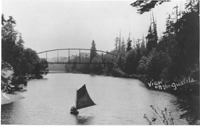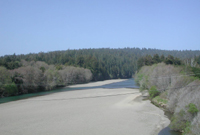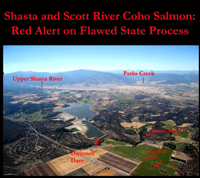Stream Flow Issues
This page reflects water issues that have risen to crisis levels and that need organized opposition by environmental groups and the interested public. We invite and welcome additional information for this page if you are tracking water issues and see other regional issues arising. Please contact us to share your information.
Russian River Flow Issues Boil Over: Groups put STATE on NOTICE of Intent to Sue to Protect endangered fish
In the aftermath of two successive years of fish kills in the Russian River watershed and the lack of effective action to protect listed species demonstrated by the agency responsible for regulating the use of water in the state, Coast Action Group, The Center for Biological Diversity and Northern California River Watch filed a 60 Day Notice of intent to sue the State Water Resorces Control Board (Director Rice). Although fish kills occurred in 2008 and were predicted to occur again in the spring of 2009, and although the National Marine Fisheries Service required the State to take emergency measures to protect the protected species, the State failed to take the requried actions and many fish facing extinction were killed - left stranded without adequate water. For more information you may contact Kimberly Burr or Larry Hanson at (707) 887-7433.
To read the press release written by Jeff Miller of the Center for Biological Diversity, go to the their website.
Coast Action Group recently issued a follow up comments on meetings held regarding Russian River frost protection and implications of follow up discussions, including water diverter driven solutions to problems. CAG points out flaws in arguments and data gaps that would prevent “solutions” from actually working for Russian River coho salmon. “The final (long term policy) for flow maintenance and frost protection must consider:
- The relationship of frost protection diversion issues with flow maintenance policy
- Analysis of Cumulative Watershed Effects (cumulative diversion) related to planned diversion policy - with limitations of loopholes that would subvert regulation
- Impoundment facilities that block migration and access to habitat must be removed
- By-pass flow numbers must be sufficient to support salmonids in all life stages
- Monitoring and reporting programs must be sufficient to assure success of regulations”
Meanwhile, there is a National Fish and Wildlife Foundation funded “Partnership” emerging with a group of familiar “stakeholders (http://www.cohopartnership.org/). Stay tuned. For more up information you may also contact Kimberly Burr or Larry Hansen at (707) 887-7433
Incidental Take Permits for Scott and Shasta Rivers
The California Department of Fish and Game (CDFG) proposed incidental take permit (ITP) for agricultural activities in the Shasta and Scott River basins for coho salmon under the California Endangered Species Act (CESA) will essentially turn enforcement of water law over to diverters in these Siskiyou County basins despite the fact that subsequent actions will not likely recover coho salmon. These severely flawed ITPs will instead cause coho salmon to go extinct and plans do not include protection of other Pacific salmon species that are currently at risk.
Action Alert! On September 22, 2009 CDFG accepted as final the Environmental Impact Reports (EIRs) for ITPs for Shasta and Scott Rivers. Earth Justice filed a lawsuit on grounds of insufficiency under the California Environmental Quality Act (CEQA) on behalf of Klamath Riverkeeper, the Quartz Valley Indian Reservation, Environmental Protection Information Center (EPIC), Northcoast Environmental Center (NEC), Sierra Club, Pacific Coast Federation of Fishermen’s Associations and the Institute for Fisheries Resources. (Read press release)
CDFG Director Donald Koch stepped down the day before the ITP lawsuit was filed and some see a tie with our ITP challenge, since Don was elevated from CDFG Region 1 and the template applied in the Shasta and Scott were thought likely to be expanded to the rest of the State. Meanwhile, fall rains were sufficient to move fish up into the Shasta and Scott Rivers and cooler temperatures have alleviated chances for a large fish kill, low flows persist in the Scott River. Field reconnaissance on the first few days of November showed that a very large run of Chinook salmon is in the Scott River canyon but unable to access upstream reaches because agricultural operations are impeding flows (Read related story)
Contact or support the organizations launching the ITP challenge in court. Let your elected officials and CDFG upper management know of your displeasure regarding the environmental and social injustice this represents.
Read about current Scott River flows and salmon runs.
Critiques of Shasta and Scott Draft ITPs by Quartz Valley Indian Community on behalf of Klamath Basin Tribal Water Quality Work Group
Shasta Draft ITP 2006
Shasta Draft ITP 2008
Scott Draft ITP 2006
Scott Draft ITP 2008
Final Scott River ITP Volume #1
Final Scott River ITP Volume #2
Final Shasta River ITP Volume #1
Final Shasta River ITP Volume #2
For more information or hard copies call:
Caitlin Bean, Staff Environmental Scientist
California Department of Fish and Game
Northern Region
601 Locust Street
Redding, CA 96001
Office: 530-225-2273
Fax: 530-225-2381
North Coast Instream Flow Study
The State Water Resources Control Board (SWRCB) Water Rights Division (WRD) published the Draft Policy for Maintaining Instream Flows in Northern California Streams in December 2007. The study was prompted by AB 2121, a bill passed in 2004 to prompt action on getting flows back in northwestern California rivers (read history of AB 2121). Peer reviewers hired by the SWRCB found that their approach to allocating “surplus” winter water was infeasible unless flow data were collected in watersheds throughout the region.
Read a summary critique of the proposed policy.
Read comments submitted to SWRCB regarding the proposed policy:
Band, L.E. 2008. Review of the Scientific Basis for the Proposed “North Coast In-Stream Flow Policy.” Prepared for the CA SWRCB WRD. University of North Carolina, Chapel Hill, NC. 12 p.
Gearhart, R. 2008. Review of Draft Policy for Maintaining In stream Flows in Northern California Coastal Streams. Prepared for the CA SWRCB WRD. Humboldt State University, Environmental Engineering Department, Arcata, CA. 7 p.
Higgins, P.T. 2008. Comments on Draft Policy for Maintaining Instream Flows in Northern California Coastal Streams. April 2, 2008. Prepared for the Redwood Chapter of the Sierra Club by Patrick Higgins, Consulting Fisheries Biologist, Arcata, CA. 49 p..
McMahon, T. 2008. Review of “Draft Policy for Maintaining Instream Flows in Northern California Coastal Streams.” Prepared for the CA SWRCB WRD. Professor of Fisheries, Montana State University, Bozeman, MT. 11 p.
Vicki Whitney who heads the SWRCB WRD told activists that they plan to move forward on policy implementation without first collecting new data. Actions may include giving a blanket amnesty for illegal impoundments smaller than 10 acre feet. This must be opposed. Stay tuned!


